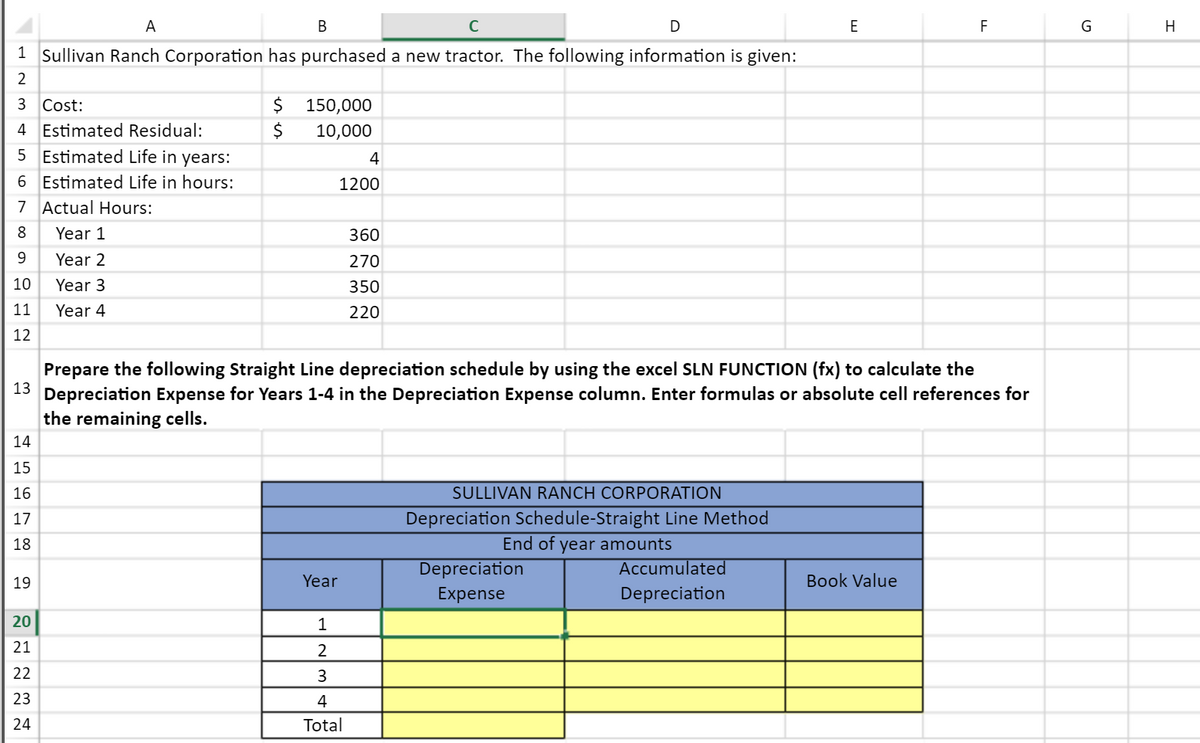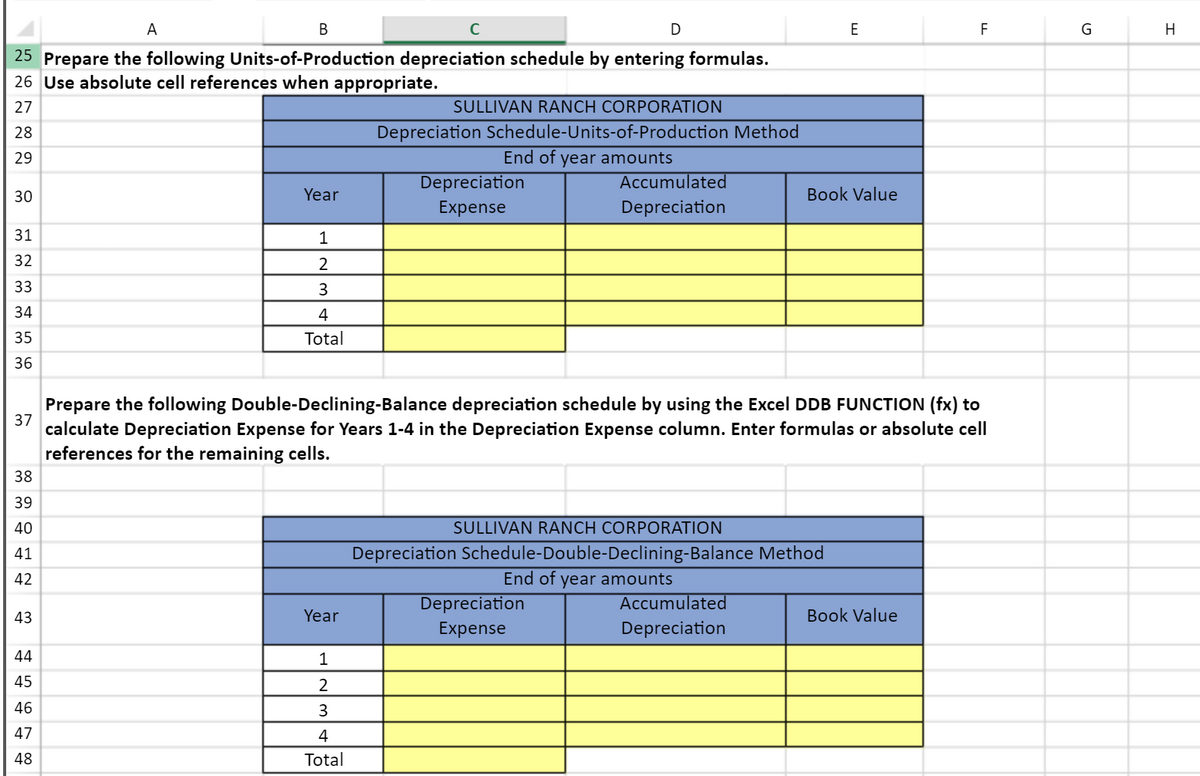1 Sullivan Ranch Corporation has purchased a new tractor. The following information is given: 2 $ 150,000 $ 3 Cost: 4 Estimated Residual: 10,000 5 Estimated Life in years: 6 Estimated Life in hours: 7 Actual Hours: 4 1200 8 Year 1 360 Year 2 270 10 Year 3 350 11 Year 4 220 12 Prepare the following Straight Line depreciation schedule by using the excel SLN FUNCTION (fx) to calculate the 13 Depreciation Expense for Years 1-4 in the Depreciation Expense column. Enter formulas or absolute cell references for the remaining cells. 14 15 16 SULLIVAN RANCH CORPORATION 17 Depreciation Schedule-Straight Line Method 18 End of year amounts Depreciation Accumulated 19 Year Book Value Expense Depreciation 20 1 21 2 22 3 23
1 Sullivan Ranch Corporation has purchased a new tractor. The following information is given: 2 $ 150,000 $ 3 Cost: 4 Estimated Residual: 10,000 5 Estimated Life in years: 6 Estimated Life in hours: 7 Actual Hours: 4 1200 8 Year 1 360 Year 2 270 10 Year 3 350 11 Year 4 220 12 Prepare the following Straight Line depreciation schedule by using the excel SLN FUNCTION (fx) to calculate the 13 Depreciation Expense for Years 1-4 in the Depreciation Expense column. Enter formulas or absolute cell references for the remaining cells. 14 15 16 SULLIVAN RANCH CORPORATION 17 Depreciation Schedule-Straight Line Method 18 End of year amounts Depreciation Accumulated 19 Year Book Value Expense Depreciation 20 1 21 2 22 3 23
College Accounting, Chapters 1-27 (New in Accounting from Heintz and Parry)
22nd Edition
ISBN:9781305666160
Author:James A. Heintz, Robert W. Parry
Publisher:James A. Heintz, Robert W. Parry
Chapter18: Accounting For Long-term Assets
Section: Chapter Questions
Problem 3CE
Related questions
Question
Sullivan Ranch Corporation has purchased a new tractor and has provided you with the information related to the purchase. The Controller has asked you to calculate the depreciation for the new piece of equipment using different
- Cell Reference: Allows you to refer to data from another cell in the worksheet. From the Excel Simulation below, if in a blank cell, "=B8" was entered, the formula would output the result from cell B8, or 360 in this example.
- Absolute Reference: Allows you to maintain the original cell reference when a formula is copied to another cell. The cell reference is "locked" by putting a dollar sign ($) before the column and row references. By default a cell reference is relative, so when you copy a formula to another cell the values update based on a relative reference. For example, if you copy the formula "=B8+B9" from cell C1 to cell C2, the formula in cell C2 will relatively update to be "=B9+B10" since the copied formula moved down one cell, the formula cell references also moved down one cell. Conversely, by adding the absolute cell reference "locks" to the equation, the formula will not change when copied to any other cell. For example, "=$B$8+$B$9" written in cell C1 is copied to cell C2, the formula in cell C2 will remain "=$B$8+$B$9". You can also use a mixed cell reference by only "locking" the column or row only ($B8 or B$8) which locks that specific column or row and the other reference becomes a relative reference and "moves" with the formula as its copied to another cell. For example, if you copy the formula "=B$8+B9" from cell C1 to cell C2, the formula in cell C2 will update to be "=B$8+B10" since the copied formula moved down one cell, the formula cell relative references also moved down one cell, but the absolute "locked" reference remained the same.
- Basic Math functions: Allows you to use the basic math symbols to perform mathematical functions. You can use the following keys: + (plus sign to add), - (minus sign to subtract), * (asterisk sign to multiply), and / (forward slash to divide). From the Excel Simulation below, if in a blank cell "=B10+B11" was entered, the formula would add the values from those cells and output the result, or 570 in this example. If using the other math symbols the result would output an appropriate answer for its function.
- SUM function: Allows you to refer to multiple cells and adds all the values. You can add individual cell references or ranges to utilize this function. From the Excel Simulation below, if in a blank cell "=SUM(B8,B9,B10)" was entered, the formula would output the result of adding those three separate cells, or 980 in this example. Similarly, if in a blank cell "=SUM(B8:B10)" was entered, the formula would output the same result of adding those cells, except they are expressed as a range in the formula, and the result would be 980 in this example.
- SLN function: Allows you to calculate the depreciation of an asset using the straight-line depreciation method. The syntax of the SLN function is "=SLN(cost,salvage,life)" and outputs the depreciation for one period. The cost argument is the initial cost of the asset. The salvage argument is the salvage value at the end of the life of the asset. The life argument is the number of periods over which the asset is being
depreciated , also called the useful life. - DDB function: Allows you to calculate the depreciation of an asset using the double-declining balance method. The syntax of the DDB function is "=DDB(cost,salvage,life,period,[factor])" and outputs the depreciation for one period. The function must include the first four arguments and has a fifth optional argument. The cost argument is the initial cost of the asset. The salvage argument is the salvage value at the end of the life of the asset. The life argument is the number of periods over which the asset is being depreciated, also called the useful life. The period argument is the period for which you want to calculate the depreciation and must use the same units as the life argument. The [factor] argument is the rate at which the balance declines, when omitted is assumed to be 2 (the double-declining balance method.)
PLEASE COMPOSE ALL ANSWERS IN EXCEL FUNCTIONS

Transcribed Image Text:A
В
D
F
G
H
1 Sullivan Ranch Corporation has purchased a new tractor. The following information is given:
2
3 Cost:
$ 150,000
4 Estimated Residual:
10,000
5 Estimated Life in years:
4
6 Estimated Life in hours:
1200
7 Actual Hours:
8
Year 1
360
9
Year 2
270
10
Year 3
350
11
Year 4
220
12
Prepare the following Straight Line depreciation schedule by using the excel SLN FUNCTION (fx) to calculate the
13 Depreciation Expense for Years 1-4 in the Depreciation Expense column. Enter formulas or absolute cell references for
the remaining cells.
14
15
16
SULLIVAN RANCH CORPORATION
Depreciation Schedule-Straight Line Method
End of year amounts
17
18
Depreciation
Accumulated
19
Year
Book Value
Expense
Depreciation
20
1
21
22
3
23
4
24
Total

Transcribed Image Text:A
В
C
F
H
25 Prepare the following Units-of-Production depreciation schedule by entering formulas.
26 Use absolute cell references when appropriate.
27
SULLIVAN RANCH CORPORATION
Depreciation Schedule-Units-of-Production Method
End of year amounts
28
29
Depreciation
Accumulated
30
Year
Book Value
Expense
Depreciation
31
1
32
33
34
4
35
Total
36
Prepare the following Double-Declining-Balance depreciation schedule by using the Excel DDB FUNCTION (fx) to
37
calculate Depreciation Expense for Years 1-4 in the Depreciation Expense column. Enter formulas or absolute cell
references for the remaining cells.
38
39
40
SULLIVAN RANCH CORPORATION
Depreciation Schedule-Double-Declining-Balance Method
End of year amounts
41
42
Depreciation
Accumulated
43
Year
Book Value
Expense
Depreciation
44
1
45
46
3
47
4
48
Total
Expert Solution
This question has been solved!
Explore an expertly crafted, step-by-step solution for a thorough understanding of key concepts.
This is a popular solution!
Trending now
This is a popular solution!
Step by step
Solved in 3 steps with 4 images

Knowledge Booster
Learn more about
Need a deep-dive on the concept behind this application? Look no further. Learn more about this topic, accounting and related others by exploring similar questions and additional content below.Recommended textbooks for you

College Accounting, Chapters 1-27 (New in Account…
Accounting
ISBN:
9781305666160
Author:
James A. Heintz, Robert W. Parry
Publisher:
Cengage Learning

Financial Accounting: The Impact on Decision Make…
Accounting
ISBN:
9781305654174
Author:
Gary A. Porter, Curtis L. Norton
Publisher:
Cengage Learning

College Accounting, Chapters 1-27 (New in Account…
Accounting
ISBN:
9781305666160
Author:
James A. Heintz, Robert W. Parry
Publisher:
Cengage Learning

Financial Accounting: The Impact on Decision Make…
Accounting
ISBN:
9781305654174
Author:
Gary A. Porter, Curtis L. Norton
Publisher:
Cengage Learning